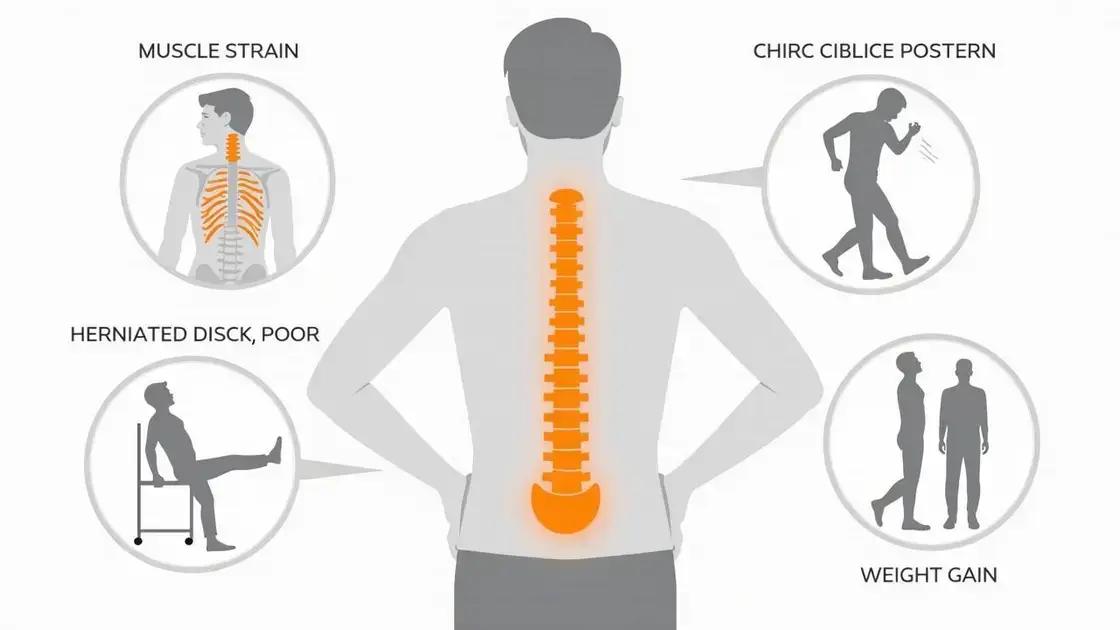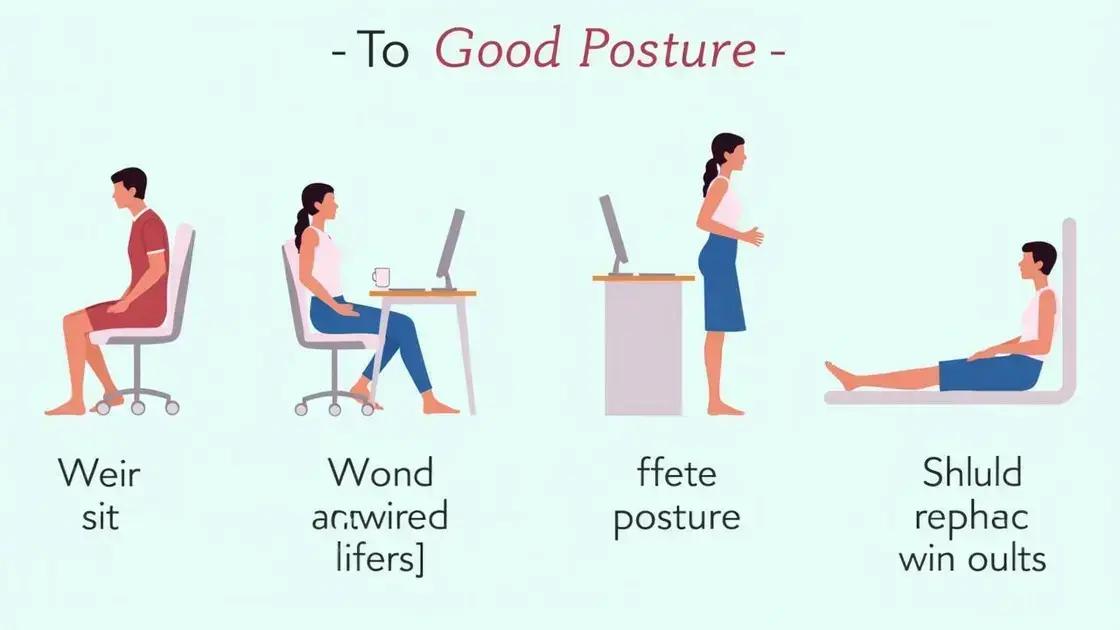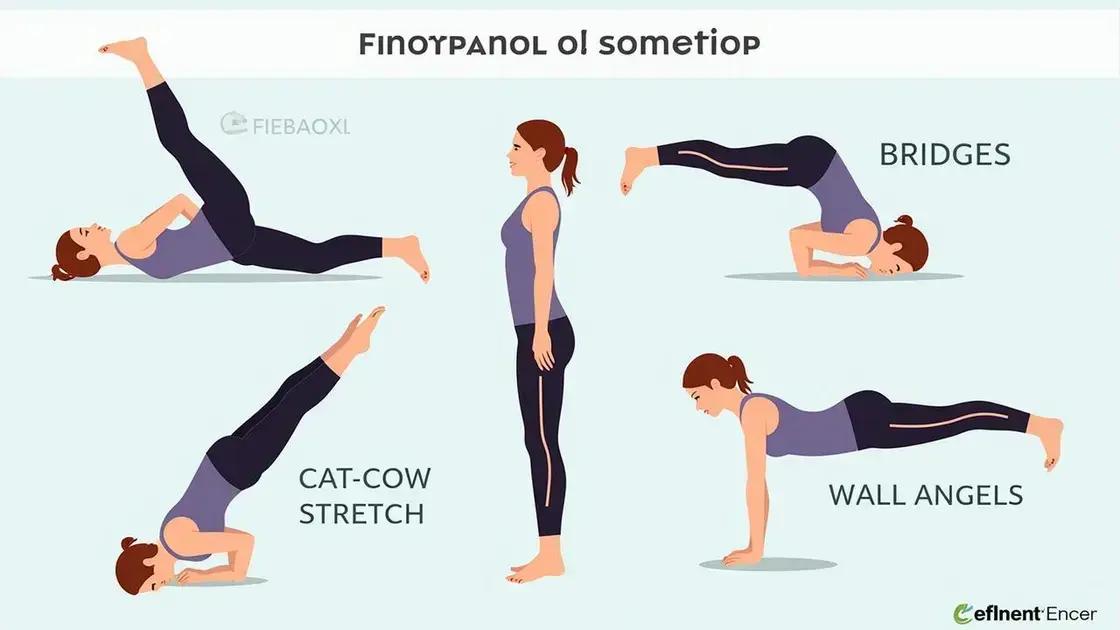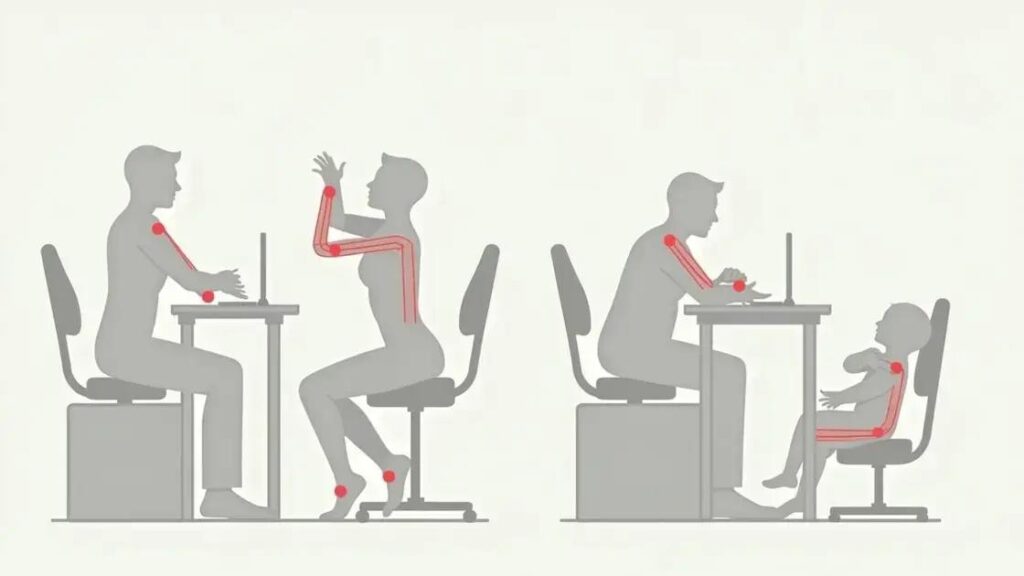To manage chronic back pain effectively, focus on postural adjustments by maintaining good posture, utilizing ergonomic furniture, and regularly performing exercises that strengthen core and back muscles.
Chronic back pain affects millions of people, but managing it can be easier with simple postural adjustments. Poor posture can lead to increased discomfort, making it essential to understand how positioning your body can dramatically affect your pain levels. In this article, we will explore how to manage chronic back pain effectively using posture, discuss essential tips for correct alignment, and provide exercises to support your back health. Proper postural adjustments not only reduce pain but can also enhance your overall well-being.
Understanding Chronic Back Pain

Chronic back pain can be a frustrating and debilitating condition. Many people experience it, but not everyone knows what causes it. Understanding chronic back pain begins with recognizing the various factors that can contribute to its onset.
One common cause is muscle strain. This can occur from lifting heavy objects improperly, sudden awkward movements, or even staying in one position for too long. Another factor is herniated discs, which can press on nerves and lead to pain. Other underlying conditions, such as arthritis, osteoporosis, or even certain cancers, can also cause or worsen back pain.
Another important aspect to consider is lifestyle choices. Lack of physical activity, poor diet, and habits such as smoking can contribute to chronic pain. Weight gain puts additional stress on your back and can lead to a cycle of pain and inactivity.
In many cases, poor posture plays a significant role in back pain. When we slouch, sit for prolonged periods, or use improper ergonomic setups, we can strain our backs over time. This is why understanding the correlation between posture and back pain management is crucial.
Knowing these factors can help in identifying potential problems and seeking effective treatments. Managing chronic back pain requires a comprehensive understanding of its causes, along with a commitment to making necessary lifestyle changes.
The Role of Posture in Back Health

Posture plays a vital role in maintaining back health. When we talk about good posture, we mean how our body is aligned when we are sitting, standing, or moving. Proper posture helps distribute body weight evenly, reducing strain on muscles, ligaments, and joints.
Poor posture, on the other hand, can lead to chronic back pain over time. Slouching while sitting, leaning forward excessively when using a computer, or standing with a hunched back creates additional pressure on the spine. This pressure may result in discomfort and decrease the natural curvature of the spine, leading to various issues.
One key factor in maintaining good posture is being aware of your body’s position throughout the day. Adjusting your sitting position and ensuring your feet are flat on the floor can greatly improve your back health. It is also important to take frequent breaks to stretch and move, especially if you spend long hours at a desk.
Ergonomics is the science of designing a workspace that fits your needs. Incorporating ergonomic furniture, such as chairs with lumbar support, can help you maintain good posture. Keeping your computer screen at eye level and using a keyboard that keeps your wrists straight can also make a significant difference.
Additionally, specific exercises can enhance your posture. Strengthening core muscles increases stability and reduces the likelihood of slouching. Overall, focusing on posture not only helps alleviate back pain but also contributes to overall physical health and well-being.
Tips for Correct Postural Adjustments

Making correct postural adjustments is essential for managing chronic back pain effectively. Here are some practical tips:
1. Be Mindful of Your Posture: Throughout the day, check in with yourself. Ensure that your back is straight, shoulders are back, and your head is centered over your spine. Awareness is the first step towards better posture.
2. Use Ergonomic Furniture: Invest in a chair that provides good lumbar support. Your feet should rest flat on the floor when seated. If your chair is too high or low, consider using a footrest or an adjustable chair.
3. Adjust Your Workspace: Keep your computer screen at eye level to avoid straining your neck. Your arms should be at a 90-degree angle while typing. Position your keyboard and mouse within easy reach to minimize awkward movements.
4. Take Breaks Regularly: Prolonged sitting can lead to bad posture. Stand up at least every hour and stretch. Simple movements like standing up, twisting your torso, or rolling your shoulders can release tension in your back.
5. Practice Core Strengthening: Strong core muscles support your spine and help maintain good posture. Incorporate exercises like planks and bridges into your routine to build strength.
6. Stay Active: Regular physical activity encourages good posture. Aim for activities like walking, swimming, or yoga, which promote flexibility and strength.
7. Fit Posture Into Daily Routines: During tasks like washing dishes or brushing your teeth, focus on maintaining a straight back and relaxed shoulders. Incorporate good posture into every aspect of your life.
Exercises to Support Postural Alignment

Engaging in exercises to support postural alignment is essential for maintaining a healthy back and alleviating pain. Here are some effective exercises:
1. Plank: Begin on your hands and knees. Extend your legs behind you, balancing on your toes and forearms. Keep your body straight from head to heels. Hold this position for 20-30 seconds, focusing on tightening your core.
2. Cat-Cow Stretch: Start on your hands and knees. Inhale as you arch your back (cow position), lifting your head and tailbone. Exhale as you round your spine, tucking your chin and tailbone (cat position). Repeat this flow for several breaths to increase flexibility and relieve tension.
3. Bridges: Lie on your back with knees bent and feet flat on the floor. Squeeze your glutes and lift your hips toward the ceiling, forming a straight line from knees to shoulders. Hold for a few seconds before lowering. Repeat for 10-15 times to strengthen your lower back and pelvis.
4. Shoulder Blade Squeeze: Sit or stand with your back straight. Draw your shoulder blades together as if you are trying to hold a pencil between them. Hold for 5 seconds and release. Repeat this exercise 10-15 times to improve upper back strength and posture.
5. Wall Angels: Stand with your back against a wall. Raise your arms in a ‘Y’ shape, keeping them against the wall. Slowly slide your arms down to a ‘W’ position while maintaining contact with the wall. Repeat this motion 10-15 times to promote shoulder mobility and improve posture.
6. Chest Opener Stretch: Stand tall and interlock your fingers behind your back. Straighten your arms and gently lift your hands away from your body while opening your chest. Hold for 15-30 seconds. This stretch counters slouching and opens up the chest and shoulders.
Incorporating these exercises into your daily routine will support postural alignment and contribute to overall back health. Aim to perform them regularly for the best results.
Managing Chronic Back Pain Through Postural Adjustments
Understanding how posture affects back health is crucial for those suffering from chronic back pain. By adopting the tips and exercises outlined in this article, you can improve your posture and alleviate discomfort.
Correct postural adjustments can lead to significant benefits, reducing strain on your back and enhancing your overall well-being. Regular practice of exercises that support postural alignment can strengthen your back and core muscles, ultimately helping you maintain better posture throughout your daily activities.
Incorporating these strategies into your life may not only diminish your back pain but can also empower you to lead a more active and fulfilling life.
FAQ – Frequently Asked Questions about Managing Chronic Back Pain
What are some common causes of chronic back pain?
Common causes include muscle strain, herniated discs, arthritis, and poor posture, often aggravated by lifestyle choices such as inactivity and obesity.
How can posture impact back health?
Good posture can decrease stress on the spine and muscles, while poor posture can lead to chronic pain and discomfort by straining the back’s natural alignment.
What are some easy tips for improving posture?
Simple tips include using ergonomic furniture, keeping screens at eye level, taking regular breaks to stretch, and being mindful of body alignment throughout the day.
What exercises can help with postural alignment?
Exercises like planks, bridges, and shoulder blade squeezes strengthen core and back muscles, promoting better posture and reducing back pain.
How often should I perform postural exercises?
Aim to perform postural exercises at least 3-4 times a week for best results, incorporating them into your daily routine as much as possible.
Can improving posture help alleviate chronic back pain?
Yes, improving posture can significantly reduce strain on the back, leading to decreased pain and enhanced overall body function.












